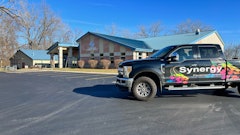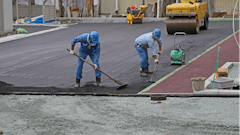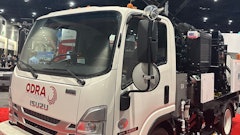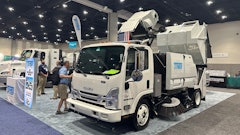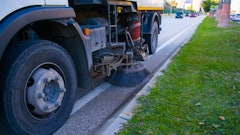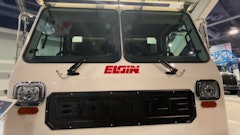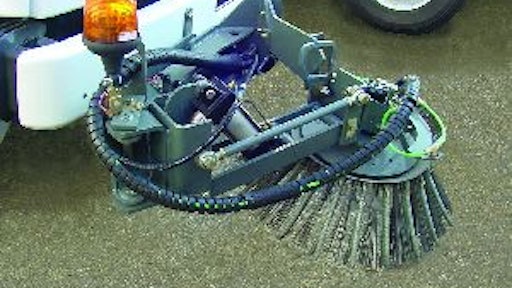
Like most pavement maintenance equipment, sweeping trucks have an abundance of OEM options available. But despite the array of options and the length of time they have been on the market, many sweeping contractors still don't know what is available to them, says Brian Giles, product manager for Elgin Sweeper Company.
There isn't enough room in this magazine to describe all the possible options and enhancements for sweepers and the benefits they can offer contractors. Tom Rokas, who works for inside sales at Tymco, recommends a contractor schedule a demo with a manufacturer so they can go into complete detail about the options, see how the options work so they can understand each particular one, and see why those options are beneficial.
One factor that may cause contractors to think twice about adding to their machines is price. "It's a fraction of the cost to add something from the factory than it is to do it after the fact. And it will probably be a better, higher quality installation if this enhancement is built into the sweeper, not on the sweeper," Giles says. "What you need to consider is 'how much can this make me on the back end?' Put aside the fact that there's going to be some paying up front to get it. 'Will it make me more money in the long run?'"
Compiled here are some of the more popular options available as well as options that contractors may not know about.
Third front broom
Most sweepers have two brooms, but this option provides a contractor with an extra third broom at the front of the truck. This third broom is attached to an arm that reaches out in front of the truck and into corners. It also helps the sweeper follow tight turns and increases the sweeping width, allowing the broom to reach places the other brooms can't.
This option is for full-sized sweepers only, Giles says. And it is starting to become popular for street sweeping contractors who run those sweepers. This is a fairly new option that has been on the market for three years, Giles adds.
Gutter broom tilt
A popular option for contractors, gutter broom tilt allows a contractor to adjust the angle of the gutter broom from inside the cab, says Raymond Massey, national sales manager for Schwarze Industries. Giles says gutter broom tilt is available on both street and parking lot sweepers and can, depending on the manufacturer, be fitted to the left side, right side, or both sides of the sweeper.
"You may go down one street and you've got about a half inch drop on your curb line. Then you go around the corner and they've added another inch and a half of asphalt without milling the old asphalt out. At that point now you're down to a two inch drop in your curb and gutter," Massey says. "You're able to adjust that broom hydraulically from inside the cab and adjust that tilt to get down in that curb and gutter to transfer that material in front of either your sweeper head or your main broom."
The gutter broom tilt option allows the operator to stay in the cab instead of getting out of the truck and manually adjusting the broom. This saves time and increases safety for the operator.
Another benefit of gutter broom tilt is that as brooms wear a contractor can tilt them to get more material onto the roadway as well as help extend the life expectancy of those brooms, Massey says.
Gutter boom extension override
This option allows operators to use the brooms in a normal extended curbside operation but also switch the brooms in various increments all the way to back under the sweeper. Normally, when you hit a switch for the gutter brooms they automatically swing out to go into the curb and gutter. With this option an operator is able to activate another switch that takes the broom arm and pulls it back in under the sweeper yet keeps it on the ground.
A sweeper is most efficient when the material it is sweeping is loose or finer particles. The gutter broom extension override enables the operator to agitate the material in front of either the sweeping head or main broom to loosen packed down material and increase pickup efficiency for a better job on the first pass, Massey says.
Broom-assisted head
This option, meant for regenerative air sweepers, increases the transferability of the material being swept which increases pickup efficiency and sweeping speeds, according to Massey.
"The regenerative air sweeper uses an air blast to create transfer which in turn equates to a suction on the far side of the sweeping head," Massey says.
"When you get into heavier material, you've really got to slow down when you don't have any type of broom in your sweeping head and allow that material to be peeled from the roadway or blasted out of the cracks in the pavement in order to be transferred. With the broom, you're able to mechanically agitate that material and transfer it." Schwarze's broom-assisted head has a broom in the suction head but forward of the blast surface.
The broom assisted head is an option a contractor can use only when needed. If a job requires sweeping up lighter material, the operator can raise the broom and use only air. "It's not a feature that you have to use continually to get the desired performance from that particular machine," Massey says.
Stainless steel hopper
A sweeper's hopper is exposed to many different materials that can cause wear and tear. A stainless steel hopper is one OEM option available for most sweepers and from different manufacturers.
It is important to keep the hopper in good shape because it is a central part of the sweeper. The stainless steel provides maximum resistance and protection against corrosion and salt spray, Rokas says.
Like most options and enhancements available for sweepers, the features of the stainless steel hopper may vary from manufacturer to manufacturer. Tymco, for example, uses 300 series stainless steel for its hoppers. The 300 series is nonmagnetic with a high nickel content and more corrosion resistance. "In certain high-impact areas of the hopper, a special stainless called Nitronic 30 is used because it has a higher impact resistance," Rokas says.
Body vibrator
A body vibrator, which is meant to help empty the hopper, is an option available for all sweeper types unless the sweeper hopper does not dump, says Troy Schuller, regional sales manager of Wayne Sweepers. The body vibrator gets mounted to the hopper and then does just as the name suggests, vibrates the hopper.
The vibration helps loosen debris inside the hopper so that it will fall out easier. As a result, a contractor will not have to scrap off as much extra debris that did not fall out when the hopper was dumped.
Hopper drain system
A hopper drain system is an option that is good for sweeping contractors in rainy climates. The drain system allows a contractor to drain off excessive water without raising the hopper.
"If your hopper gets full of water you want to go dump it. And if you raise the hopper to go dump it, the water will go everywhere," Rokas says. The drainage system prevents that.
The system consists of a folded flap and a metal screen over the hopper. The flap allows the water to flow out while the metal screen keeps trash and debris in the hopper. One feature of Tymco's hopper drain system is a collapsible hose. After the water drains through the hose, it collapses and does not allow air into the sweeper. This keeps the contractor from having to go back and forth to take the hose down to drain and put back up after draining is finished.
Auxiliary lighting
This OEM option benefits contractors by increasing safety. These traffic warning devices can be top- or rear-mounted to a sweeper and come in an array of LEDS and programmable lights. Auxiliary lighting is available for all types of sweepers and contractors.
Most auxiliary lighting allows a contractor the choice of different colored lights as well as different programmable flash patterns and times. Giles says the newer auxiliary lighting available also has easier mounting and a lower current draw than previous options available.
Sound suppression package
Sweeping contractors always need to be aware of their environment. And depending on where they are sweeping, noise restrictions may be an issue. A sound suppression package is one option available for contractors who deal with noise issues.
A sound suppression package can lower the overall decibel output of the sweeper, sometimes up to 70%, Massey says. Having a quieter sweeper helps contractors who sweep at night or in areas where noise must be kept down.
The operator also benefits from less noise. A quieter sweeper will cause less damage to an operator's ears. Massey says a sound suppression system also allows an operator to hear what is going on around him, which can lead to a better awareness of the surrounding environment.
Hand hose
This OEM option is designed to help a contractor clean areas that the sweeper and its brooms cannot reach. In essence, it turns the sweeper into a large vacuum.
Hoses differ with each manufacturer. Tymco, for example, offers a 10-ft. hose with a 40-in. nozzle that is available for all its sweepers. Elgin offers a hose with the option of adding 4-ft. extensions. Giles says Elgin's hose is meant for air street sweepers because it is a larger hose. But contractors who sweep parking lots can also benefit from this addition.
Adding a hand hose to a sweeper not only allows a contractor to clean areas outside of the sweeper's path, it also has the ability to add a supplement to business. "It would allow them to supplement their core business by cleaning catch basins, or settling ponds, or any place where you'd need to pick up stuff off the ground and put it in your truck," Giles says.
The ability to use your sweeper as a sweeper and a vacuum can be quite beneficial for contractors working on constructions sites, Giles adds. This option allows them to clean up piles of debris that may have piled up from loading trucks, for example. "Working in the construction end of sweeping, it probably ought to be a core option that's part of their day to day business," he says.
Camera systems
Although this is not one of the most popular OEM options contractors choose, Giles says he thinks it should be. This option enhances safety by allowing a contractor to see behind and to the sides of the truck by looking at a small monitor in the cab. Being able to see behind the sweeper helps prevent damage to the back of the sweeper when it is backing up.
"There is some money that can be saved if the operator can see the back of the machine as he's backing up and will stop backing into things," Giles says.
A camera system that can record also helps with accidents or accusations of damage. Being able to review what happened can help protect a company if accusations are not true, Giles adds.
Extra water capacity
One item that many contractors look to add to their sweepers is extra water capacity. This can be done in the form of replacing or adding on to the existing water tank or adding additional tanks to the machine. The obvious benefit is that a contractor will not have to go and fill up the water tank as often, saving labor and time. But adding extra water capacity is not an option for all contractors.
Schuller says a contractor using a dustless machine would not need extra water capacity. He also says that water isn't usually a big concern for parking lot sweeping contractors, so this may not be an option they are concerned with.
If a contractor does want more water capacity, one thing he or she needs to keep in mind is weight restrictions. This is a major factor on whether or not a sweeper can support extra water capacity - it may be at the weight limit already - as well as how much extra weight can be added.
Automatic lubrication
Sweeping trucks have a lot of moving parts that are exposed to a dirty environment. Because of this, proper lubrication of these parts is essential to keep the sweeper operating in a good condition. Automatic lubrication, or auto lube, is a device that automatically greases the sweeper's parts whenever needed.
Although this tends to be a more expensive enhancement, it is often worth it in the long-run, Giles says. Auto lube can save a contractor money and uptime. "It's kind of a 'pay me now or pay me later' proposition," Giles says, adding that auto lube is available for any sweeper, and it is an option that all contractors should consider.
Massey says auto lube systems help eliminate failure rates for bearings and other wear parts. The system is tied into a truck's computer on a timer and releases grease based upon the machine's requirements.
This self-contained device only requires a contractor to fill the grease reservoir every now and then. The contractor's only other role in the greasing process is to turn the sweeper on. Auto lube systems only run when the sweeper is running, Giles says.
High-pressure wash
High-pressure wash is an option available for any sweeper and is another way to turn a sweeper into multiple pieces of equipment, Giles says. The high-pressure wash can be permanently mounted to a sweeper and used as a high-pressure washer. Because it is mounted to the sweeper, the pressure washer is run by the sweeper's hydraulic system and does not require an extra water source separate from the sweeper. This is an option Giles says is used more by street sweeping contractors as opposed to parking lot sweeping contractors.
The high-pressure wash can be used to remove debris and clean the pavement. In addition, the pressure washer can be used to clean equipment, including the sweeper it is mounted to.
Conveyor/Drive system
If a contractor runs a mechanical sweeper the conveyor is one option to consider. What type of conveyor or drive system a sweeping contractor should add depends on the type of jobs the machine is doing.
"If they're doing asphalt millings, which is a real heavy material, then they'll go with a chain and sprocket type drive," Schuller says. "We've got other contractors out there that don't do as much milling and they just do normal sweeping; they would rather have a belt drive system."
Having the correct type of conveyor and drive system can save a contractor money down the road on the rebuilding of these parts. If a contractor is using the wrong type of system, belts are going to tear faster and need replacing. If they are used in the right application they'll last longer and make replacement easier, Schuller says.
A related add-on is an optional camera that looks at the conveyor system. Since this is a part an operator needs to keep clean the camera will help identify if the conveyor has become overloaded.
Auto raise
This OEM option can go by many different names depending on the manufacturer, but its main purpose is to help keep brooms and other sweeping gear in good working condition. "The purpose for the auto raise option is to allow the operator safe control over his sweeping components," Schuller says.
The setup depends again on the manufacturer, but the auto raise can be activated by pressing a button or automatically when the transmission of the chassis goes into reverse. Not only does this option help keep sweeping gear in good shape, but it also allows for safer operation when backing up, Schuller adds.
Contractors who own regenerative air sweepers would likely not want this option because picking up the sweeper head can result in dirt and debris getting blown around, Schuller says.
Rubber-lined blower
What contractor wouldn't like to extend the working life of his or her sweeper and its parts? A rubber-lined blower is one way to do that. With this option, the sweeper blower's paddles are covered with a rubber coating that helps reduce wear caused by abrasive materials and extend the blower wheel's life.
Rokas says a rubber-lined blower can be installed on both parking lot and street sweepers and can benefit every contractor. "The blower is kind of the heart of the machine," he says. "Anytime you can get more life out of it it's better because you obviously don't have to change it as often."













